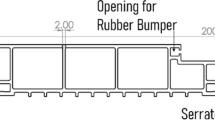Abstract
This paper is concerned with a polymer extrusion instability and the effect of introducing slip by means of a thin lubricating gas layer between the extrusion die wall and the flowing polymer melt. Gas-assisted extrusion (GAE) experiments were carried out using high-density polyethylene (HDPE) and linear low-density polyethylene (LLDPE) for a number of different gas injection die geometries. The stress distributions within the polymer melt were monitored during extrusion using flow birefringence. Polyflow numerical simulations were used to calculate the local stress concentrations in the melt at the die exit, as these were believed to be related to the occurrence of sharkskin. Simulations were also used to observe the effect of a full slip boundary condition as imparted by GAE. A key finding of the paper is that GAE in the parallel section of the die wall simply moved the local exit stress concentration upstream to the point of gas injection, and therefore did not reduce sharkskin. Simulations indicated that for correctly designed dies, the local surface stress concentration would be reduced. However, it was found experimentally that it was not possible to obtain a stable gas layer for this die design with upstream gas injection. A numerical investigation, involving simulations of varying levels of partial slip along the die wall, indicated an optimum level of slip where the stress concentrations were reduced. It is speculated that this is the reason that coatings such as PTFE, which impart a partial slip, can reduce sharkskin while GAE does not. The findings show that a controlled level of partial slip lowers the overall stress concentrations.














Similar content being viewed by others
References
Tordella JP (1969) Rheology, vol 5. Academic, New York
Petrie CJS, Denn MM (1976) Instabilities in polymer processing. AIChE J 22(2):209–236
Larson RG (1992) Instabilities in viscoelastic flow. Rheol Acta 31:213–263
Wang SQ (1999) Molecular transitions at polymer/wall interfaces: origins of flow instabilities and wall slip. Adv Polym Sci 138:227–275
Denn MM (1990) Issues in viscoelastic fluid mechanics. Annu Rev Fluid Mech 22:13–34
Denn MM (1992) Surface-induced effects in polymer melt flow. In: Moldenaers P, Keunings R (eds) Theoretical and applied rheology. Proc XIth Int Congress on Rheology. Elsevier, New York, pp 45–49
Denn MM (2001) Extrusion instabilities and wall slip. Annu Rev Fluid Mech 33:265–297
Rutgers RPG, Mackley MR (2000) The correlation of experimental surface extrusion instabilities with numerically predicted exit surface stress concentrations and melt strength for linear low-density polyethylene. J Rheol 44(6):1319–1334
Piau JM, El Kissi N, Toussaint F, Mezghani A (1995) Distortions of polymer melt extrudates and their elimination using slippery surfaces. Rheol Acta 34:40–57
Migler KB, Lavallee C, Dillon MP, Woods SS, Gettinger CL (2001) Visualizing the elimination of sharkskin through fluoropolymer additives: coating and polymer–polymer slippage. J Rheol 45(2):565–581
Liang RF, Mackley MR (2001) The gas-assisted extrusion of molten polyethylene. J Rheol 45:211–226
Arda DR (2003) The sharkskin extrusion instability and its minimisation in polyethylene processing. PhD Thesis, University of Cambridge, Cambridge, UK
Crochet MJ, Walters K (1993) Computational rheology—a new science. Endeavour 17(2):64–77
Lipscomb GG, Keunings R, Denn MM (1987) Implications of boundary singularities in complex geometries. J Non Newton Fluid Mech 24(1):85–96
Renardy M (2000) Current issues in non-Newtonian flows: a mathematical perspective. J Non Newton Fluid Mech 90(2–3):243–259
Stewart CW (1993) Wall slip in the extrusion of linear polyolefins. J Rheol 37(3):499–513
Venet C, Vergnes B (1997) Experimental characterization of sharkskin in polyethylenes. J Rheol 41(4):873–892
Barone JR, Plucktaveesak N, Wang SQ (1998) Interfacial molecular instability mechanism for sharkskin phenomenon in capillary extrusion of linear polyethylenes. J Rheol 42(4):813–832
Kulikov O, Hornung K (2003) A simple way to suppress surface defects in the processing of polyethylene. In: Proc 12th Int Conf on Deformation, Yield and Fracture of Polymers, 7–10 April 2003, Cambridge, UK, pp 411–414
Acknowledgements
The authors would like to thank the EU for the funding of this project (Postpone Polymer Processing Instabilities (3PI) Competitive and Sustainable Growth), Cambridge Reactor Design (CRD) for help with the design and manufacture of gas injection dies, and Alan Heaver for help in obtaining SEM images.
Author information
Authors and Affiliations
Corresponding author
Rights and permissions
About this article
Cite this article
Arda, D.R., Mackley, M.R. Sharkskin instabilities and the effect of slip from gas-assisted extrusion. Rheol Acta 44, 352–359 (2005). https://doi.org/10.1007/s00397-004-0416-1
Received:
Accepted:
Published:
Issue Date:
DOI: https://doi.org/10.1007/s00397-004-0416-1




